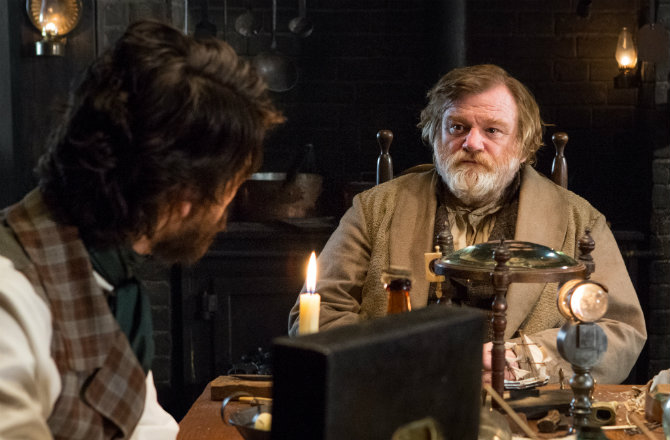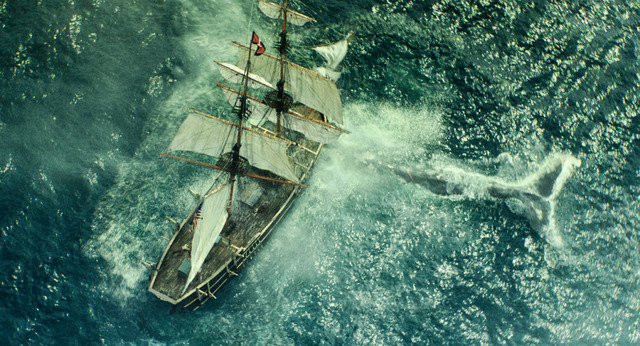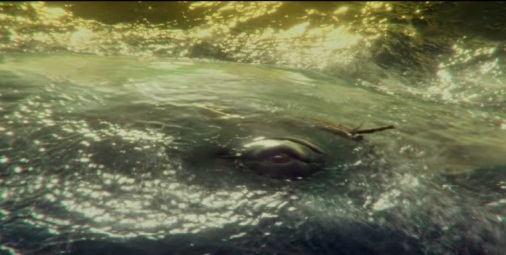Ron Howard´s In the Heart of the Sea (2015), based on Nathaniel Philbrick´s book (2000) of the same name, illustrates the sinking of the whaling ship Essex in 1820 and the crew´s struggle for survival. It is framed by a conversation between Herman Melville, who wanted to gather information to write a novel, and Thomas Nickerson, who himself served on the Essex as cabin boy when he was a teenager.

Hermann Melville interviewing Tomas Nickerson
After having refused to discuss the tragedy of the Essex for a very long time, Nickerson eventually begins to explain what had happened in 1820 and the time after. Being part of the whale oil industry the Essex headed out to catch whales. The voyage ended when a huge white sperm whale attacked the ship and caused it to sink. The surviving crew went through many hardships, great crew losses and committed atrocities to survive. The fear of death while being stranded was a constant companion. As well as the several encounters with the massive “demonic” white whale. Few survivors where eventually rescued and brought back to the harbor of Nantucket. Having experienced life threatening situations and committed abominations, Captain Pollard and his first mate where asked to white wash the fact that a white whale caused the Essex to sink, for the sake of the oil industry. However, the captain decided to tell the truth. The film ends by Herman Melville explaining that he will not include all the information in his book. It is supposed to be “a work of fiction inspired by truth”.
Being a bibliographical-adventure-drama that portrays the image of struggle of survival with somewhat historical elements and action-packed scenes, the film basically combines aspects of many different genres. However, the fact that the film features a sea voyage characterizes it as adventure or more precisely a sea adventure. Adventure films can often be traced back to literary motives. Novels have dealt with these kinds of themes for a longer time. One key element of this genre is the impulse that drives the characters[1]. Often it is a treasure hunt, the pursuit of happiness, the voyage itself or other longings. In In the Heart of the Sea many of these driving motives can be found. On the one hand, the crew wants to make profit being part of the whale oil industry. On the other hand, it seems as if Owen Chase, the first mate, seeks for the fulfillment of his destiny as captain. The adventure seems to be a lifelong project, filled with moments of revenge and recognition. The very physical and action-packed scenes are distinctive for sea adventures, as well as the “use of naval iconography”[2]. It serves as authentic portrayal of the rough lives of sailors. These kinds of adventures tend to let their characters mature and eventually lead men to a better understanding or even appreciation of nature. Being driven by madness the crew is being put back into place by the forces of nature. Spectacular impressions of nature, as in this case the sea, are essential for adventure films. The voyage allows men to “overcome individual boundaries”[3] and experience worlds and forces that are beyond civilization’s apprehension.
In the Heart of the Sea does not offer a great variety of animal presence; however, the few portrayals serve very important purposes. The film shows how important whaling was for the industry. Whalers headed out to fill the ship with thousands of barrels of oil, which could then be offered and sold on the international market. Therefore, the presented whales could be seen as commodity. The film does not stress the hunt as particularly interesting and enjoyable for the crew, since it is a dangerous job. Nevertheless, the encounter with the first whale they caught was a very action and tension packed scene. The actual fight between man and nature seemed to be very competitive and therefore almost like an enjoyable competition. The viewer’s attention was caught by not knowing which side is going to succeed. Even among the crew the men were not sure whether this fight will be a success or not. Eventually, the whale gave up and was dragged on board. The human victory over an animal causes a feeling of invincibility, which will fade by the next dramatic whale encounter. Speaking of whaling and the whales as being goods for industry the film never stresses the beauty of whale pods innocently traveling through the oceans. Rather than perceived as huge, magnificent and rare creatures of the sea, whales are only seen as floating animals composed of money. They do not even seem to have a chance to escape. Even after months of lacking whale encounters the crew does not appreciate nature and the whale pods as something rare, but as chance to do their job, fill the boat with oil and sail back home. Eventually, this craving and the madness that caused the captain and his first mate to sail out that far will result in being truly exposed to the forces of nature and the “demonic” white whale.
The white bull sperm whale has a very different impact than his conspecifics. Even though, sperm whales tend to have a very distinct social behavior and gather in big pods to travel through the seas[4], the behavior of the white whale is special. He is depicted as, even for a bull, massive whale marked by several old injuries and scars. He basically emerges out of nowhere and attacks the whalers, turning himself into the target of their rage.

Whale attacking the Essex
This behavior could be interpreted as very protective towards the other female whales and their offspring. He aggressively attacks the Essex and causes it to sink. As opposing to the other whales he seems to be very capable of dealing with humans. For the whalers he is a demon. The film shows how aggressively and purposely he caused damage and death just as the humans caused death among the whales beforehand It seems as if he is the men´s opponent in nature that puts mankind back into their place. Due to his size he can be considered as very old and therefore experienced. As the crew heard beforehand, he must have caused other ships to sink as well. Due to the fact that the Essex sailed out very far to reach the grounds of the huge whale pods it seems as if they crossed a natural line. Greed and madness led the crew to the white whale and thereby caused the ship to sink. The bull sperm whale might therefore be perceived as responsible for restoring balance. Mankind was going too far by intruding even in the outermost places to make profit. He was illustrated as “demon whale” by the crew, since he caused much damage and deaths, however, the whale also served as trigger for reconsidering morals and behavior. Even though Owen Chase was first driven by the pure desire for revenge, he eventually got to realize something that helps him to retrieve his inner peace. This scene seems to be very interesting compared to the famous ending of the 1956 version Moby Dick. Ahab never got to the point, where he was able to let go of his anger and thoughts of revenge, which caused his own death. By being so close that Chase and the whale were face to face he was able to let go of his thirst for revenge, he maybe even recognized the whale as actual living being that needs to be appreciated. The whale then never appears again in the film. Overall he could be summarized as the executive of nature and the judge of men.

Being face to face with the white whale
The last important human-animal encounter in the film concerns a scene close to the end. After the remaining crew had been stranded at sea for several months they hear seagulls. These animals instantly cause the cabin boy, Thomas Nickerson, to know that they are finally saved, since they must be close to civilization. The birds basically serve as sign of rescue. They guide the starved and almost dead remaining members of the crew back to live. The viewer at once without even seeing the coast and harbor knows that the struggle found an end, due to the pure associations triggered by the birds. Seagulls being clear symbols of sea-adventure-dramas finally introduced the end of the struggle for survival. One can also identify a connection to the 1956 film version of Moby Dick concerning the presence of the birds. In that film, the birds travel with the whale, due to his great size. He is even characterized as island by Ahab and his crew. Being so close to actual land, also Owen Chase and his fellow survivors experience the presence of the birds.
The film presents animals, namely sperm whales, as being exploited by mankind for profit. The whales are being chased and hunted for the sake of the whale oil industry. They are shown as vulnerable without any actual chances to escape their destiny. The sperm whales are at the mercy of humankind taking advantage of their situation without any signs of moral regret. Even though, whaling is not portrayed as being actually enjoyable. The men never show any signs of empathy towards the animals. Hence, at the time the film is set this was an absolutely normal job. However, the viewer might still be thinking of implicit criticism towards whaling, since the morbid scenes of a whale being chased until exhaustion, eventually killed and dragged on board is nothing one would nowadays appreciate seeing though it is still practiced. The sperm whales never seemed to have had a chance to stand up for their right to live and represent the innocence of nature humans intrude and take for granted without even thinking about any consequences. To balance this helpless situation out, the white bull sperm whale is showing actual animal agency. He emerges as defender of his own kind and thereby nature. He is set up to be the actual opponent that can easily put up resistance. The white whale restores the natural boundary between humans and whales by purposely fighting and defending his territory against the intruders. He fights for his sheer right to exist and be accepted. This behavior cannot just be perceived as act of violence to defend the crew; his opposition may have also caused impulses in Chase Owen and the other survivors for rethinking the whale oil industry, as the former first mate never signs up on a whaler again after his return. This confirms signs of implicit criticism towards whaling which is again revisited as in the end of the film Melville and Nickerson talk about the discovery of fossil oil.
Being inspired by Philbrick’s 2000 nonfiction writing, Ron Howard took his own turn in visualizing the matter of Melville´s Moby Dick as well as the sinking of the Essex. As often attempts to film narratives, such as Philbrick´s novel, seem to be failing, also his effort in presenting an epic adventure drama somehow got lost in itself. By trying to show what had actually happened to the whaler and its crew, the big white whale that might actually have caused most of the viewers to watch the film, almost got forgotten. Nevertheless, viewers can enjoy visual pleasurable scenes of an authentic sailor´s life and the struggles to be stranded. Storms and spectacular whale chases might compensate the high expectations of “Ron Howard directing Thor in a big-budget true story that inspired Moby-Dick”[5]. It is always hard for films to live up to a novel; hence, trying to combine two seems to be not even possible without having to make concessions. However, viewers enjoying interpretative approaches concerning animal representation might still have a pleasure watching Howard´s attempt on the two epic stories, as there is much more depth in the animal representation than movie audiences might obviously take into account.
Further readings:
Nathaniel Philbricks “In the Heart of the Sea”
Link: http://nathanielphilbrick.com/books/in-the-heart-of-the-sea/
Herman Melville “Moby Dick”
http://americanliterature.com/author/herman-melville/book/moby-dick-or-the-whale/summary
Moby Dick film 1956
http://www.imdb.com/title/tt0049513/
http://www.smithsonianmag.com/history/the-true-life-horror-that-inspired-moby-dick-17576/?no-ist
Bibliography:
http://www.imdb.com/title/tt1390411/?ref_=nv_sr_1
Taves, B. (1993). The Romance of Adventure. The Genre of Historical Adventure Movies. Jackson, MS: University Press of Mississippi. pp. 3-50.
Traber, B. (2004). Filmgenres Abenteuerfilm. Stuttgart: Reclam. pp. 9-29.
Whitehead, H. (2003). Sperm Whales: Social Evolution in the Ocean. Chicago: University of Chicago Press.
images:
http://ia.media-imdb.com/images/M/MV5BMjA5NzUwODExM15BMl5BanBnXkFtZTgwNjM0MzE4NjE@._V1_SX214_AL_.jpg
http://www.pointofgeeks.com/wp-content/uploads/2015/09/in-the-heart-sea-whale-eye-pointofgeeks.jpg
http://www.pointofgeeks.com/wp-content/uploads/2015/09/in-the-heart-sea-whale-eye-pointofgeeks.jpg
http://static.ddmcdn.com/gif/02-heart-sea-melville.jpg
[1] Tavis, B. (1993), p. 29.
[2] Tavis, B. (1993), p. 30.
[3] Traber, B. (2004), p. 22.
[4] Whitehead, H. (2003).
[5] Mark Hughes http://www.forbes.com/sites/markhughes/2015/12/10/review-in-the-heart-of-the-sea-a-visually-breathtaking-adventure/#cf87626d5d11